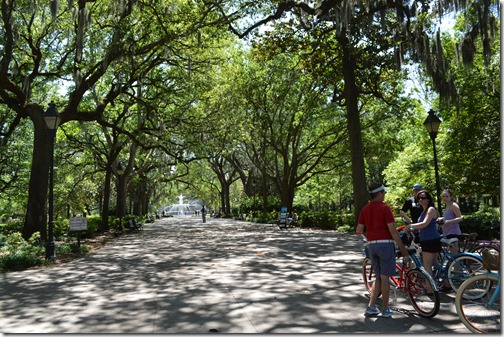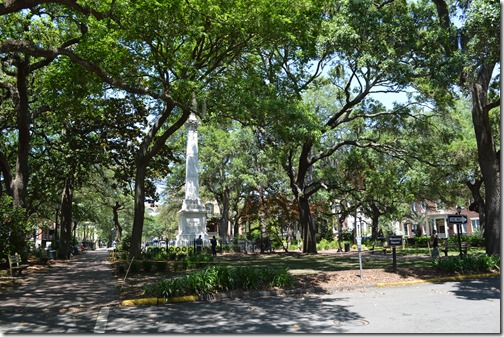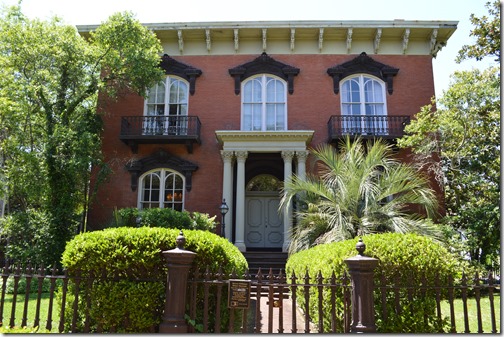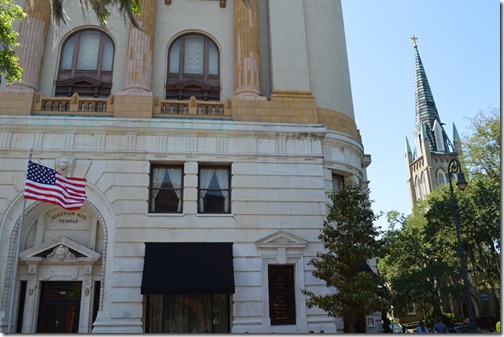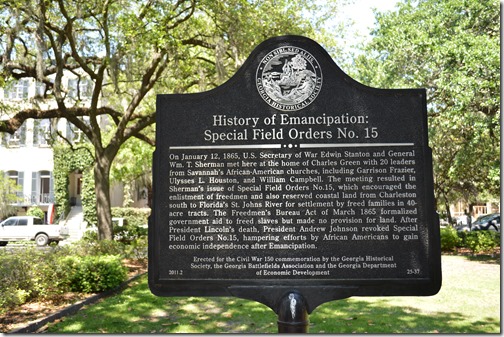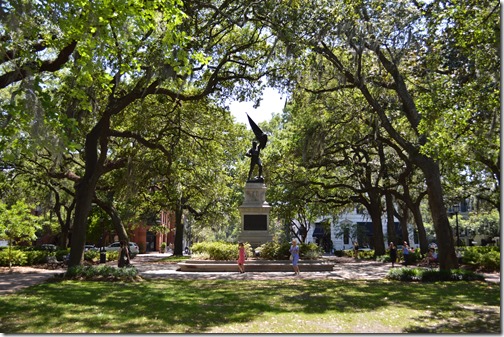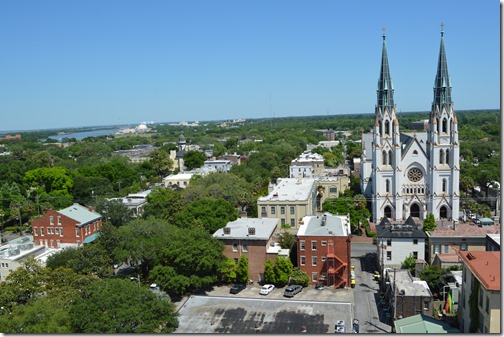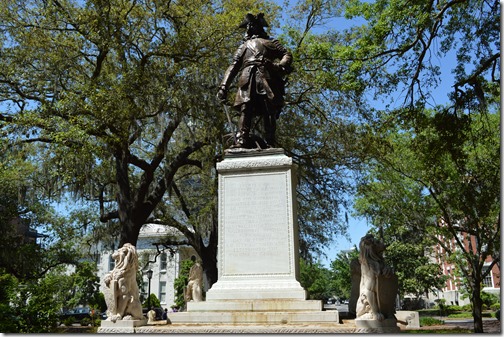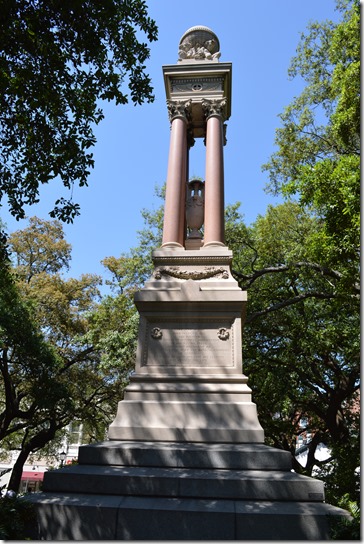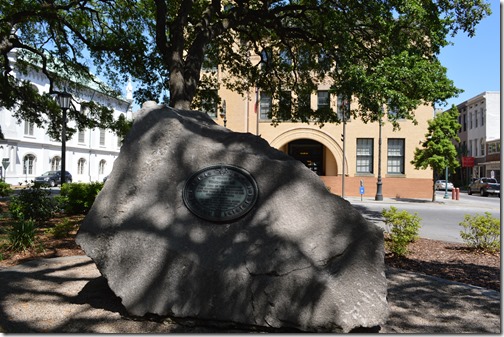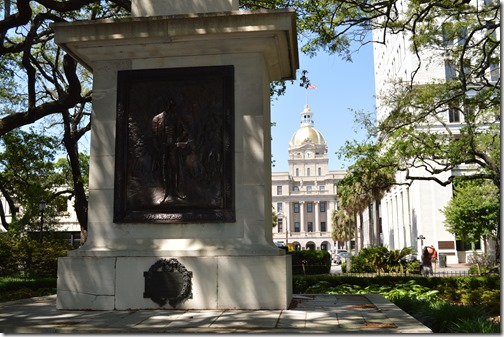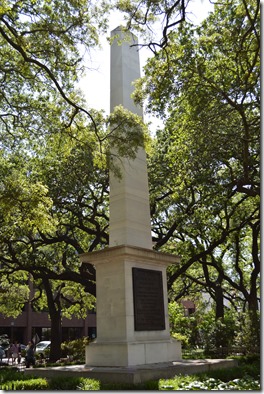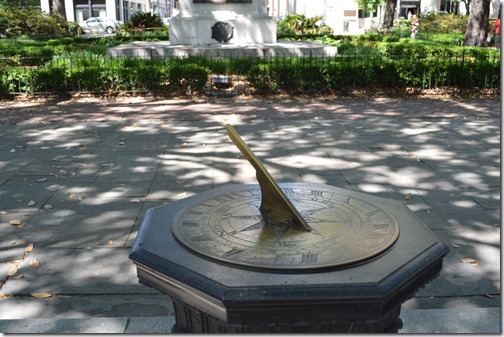The squares of Savannah, Georgia shed plenty of history on the Revolutionary and Civil Wars through monuments and signs. My earlier post described five of the Savannah’s 22 squares from Ellis Square to Chatham Square and Forsyth Park.
This post describes the five city squares along Bull Street walking from Forsyth Park back to the riverfront. These five squares: Monterey, Madison, Chippewa, Wright, and Johnson are described as the Crown Jewels of Savannah based on the grand monuments in these spaces. Along the route I passed several historical buildings walking from Forsyth Park back to the Savannah River area. One of my stops was the Hilton De Soto Hotel beside one of the city squares.
Savannah history cycling tour in Forsyth Park.
Monterey Square (1847)
I was surprised to see a square named after Monterey, although the spelling leads to some confusion. The square supposedly commemorates the 1846 Battle of Monterrey where Zachary Taylor led an army to victory in the Mexican American War and the boundary dispute with the Americans claiming the Rio Grande River was the legitimate border for Texas.
Pulaski Monument in Monterey Square.
Casimir Pulaski was a Revolutionary War Polish General who suffered a mortal wound in the Battle Of Savannah October 9, 1779 when the French and American lines attacked the British. He led the cavalry to rally the disorganized Allied columns. There is a Revolutionary War soldier buried at the monument, however, it is believed that Pulaski was buried at sea when he died from his wound on board a ship bound to Charleston, SC.
Monterey Square is one of the most famous of Savannah’s 22 squares for the Jim Williams home beside the square, made famous in the 1994 nonfiction story Midnight in the Garden of Good and Evil by John Berendt and the 1997 film of the same name directed by Clint Eastwood.
Mercer-Williams Home on Monterey Square is the home from the murder story Midnight in the Garden of Good and Evil. Jim Williams was the antique dealer from the story on trial for the murder of a local male prostitute in this home. The house was originally built by an ancestor of Savannah native songwriter Johnny Mercer.
Madison Square (1837)
Madison Square is named for President James Madison. There is a plaque on a cannon in the square stating this is the starting place for two of Georgia’s first roads. The Ogeechee Road leading to Darien, Georgia was started in 1733 and the first highway in Georgia. The Augusta Road led to Augusta, Georgia.
There is also a marker commemorating the first Scottish Rite of Freemasonry in Savannah in 1796.
Scottish Rite Temple, Savannah.
Hilton Head Island could have been an historically African American resort.
One of the most interesting markers in Madison Square is the sign for History of Emancipation: Special Field Orders No. 15.
“On January 12, 1865, US Secretary of War Edwin Stanton and General W,. T. Sherman met here at the home of Charles Green with 20 leaders from Savannah’s African-American churches, including Garrison Frazier, Ulysses L. Houston and William Campbell. The meeting resulted in Sherman’s issue of Special Field Orders No. 15, which encouraged the enlistment of freedmen and also reserved coastal land from Charleston south to Florida’s St. Johns River for settlement by freed families in 40-acre tracts. The Freedmen’s Bureau Act of March 1865 formalized government aid to freed slaves but made no provision for land. After President Lincoln’s death, President Andrew Johnson revoked Special Field Orders No. 15, hampering efforts by African Americans to gain economic independence after Emancipation.”
Jasper Statue in Madison Square.
Sgt. William Jasper is a noted hero of the Revolutionary War. At the battle of Sullivan’s Island on June 28, 1776 in what is now Fort Moultrie (then Fort Sullivan) in Charleston Harbor, Sgt. Jasper recovered the South Carolina flag after British cannon shot the flagstaff down. He held the flag on a temporary staff in the line of fire until a new staff could be raised for the flag. In 1779, Jasper was mortally wounded in the unsuccessful attempt to retake Savannah from the British forces. The British southern line of defense was at the location of Madison Square. The British held Savannah from December 29, 1778 to July 11, 1782. On October 9, 1779 there was the Battle of Savannah with an assault on the British lines by 3,500 French troops commanded by Count D’Estaing and 1,500 Georgia, South Carolina and Continental troops commanded by Major General Benjamin Lincoln.
This was the failed attempt in the Battle of Savannah when General Pulaski and Sgt. William Jasper were both killed in action.
Hilton DeSoto Hotel is at Madison Square on the location of the 1890 DeSoto hotel.
View of St. John the Baptist Cathedral from balcony of 15-story Hilton DeSoto.
Chippewa Square (1815)
Chippewa Square was laid out in 1815 to commemorate the soldiers who died in the Battle of Chippewa during the War of 1812. There is a 1910 statue of James Oglethorpe, founder of Georgia, as the centerpiece for the square.
James Oglethorpe Statue in Chippewa Square, Savannah.
Perhaps even more notable for Chippewa Square is this was the location of the famous Forrest Gump bench scene. The bench used in the film was not one of the actual benches in Chippewa Square. There is a prop bench from Forrest Gump in the Savannah Visitor’s Center.
Wright Square (1733)
Savannah’s second oldest square was originally called Percival Square after Lord Percival who gave Georgia its name as a tribute to King George II. The square was renamed Wright Square in 1763 to honor James Wright, the third and last of Georgia’s royal governors prior to the formation of the United States.
Wright Square has an interesting history as the burial place of James Oglethorpe’s Native American friend Tomo-chi-chi who helped Oglethorpe with Indian relations during the early settlement of Georgia. Tomo-Chi-Chi was the leader (mico) of the Yamacraws, a tribe of the Creek Indian Nation. He helped ratify the treaty on May 21, 1733 that established the Georgia Colony. In 1734 Tomo-Chi-Chi visited the English Court and met the King. He died October 5, 1739 and at his request was buried in Savannah with military honors. His grave was marked in the traditional tribal way with stones gathered from the local area.
William Washington Gordon Monument, Wright Square.
This monument to William Washington Gordon (1796-1842) has a Savannah scandal perhaps greater than the Jim Williams murder trial. William Gordon was the first Georgian to graduate from the United States Military Academy. After serving in the military for a couple of years, he returned to Savannah to study law and married the niece of lawyer James Moore Wayne. His granddaughter was Juliette Gordon Low, founder of the Girl Scouts and the Wayne-Gordon House where Juliette was born and raised was Savannah’s first registered National Historic Landmark. William Gordon served as Savannah’s mayor 1834-36 and in the Georgia House of Representatives (1835) and Georgia Senate (1838). He founded the Central Rail Road and Banking Company of Georgia.
A year after Gordon’s death in 1842, the railroad he founded desecrated ancient Creek tribal burial grounds when it constructed a rail line through the land that is now Ocmulgee National Monument on a site that has had 17,000 years of human habitation. From 950 to 1150, there were large earthen structures built at Ocmulgee and the development of towns with sophisticated farming practices. In 1540, Hernando deSoto explored the area and contact brought diseases to the native people. The Creek tribal people of the 1800s still made pilgrimages to the mounds of Ocmulgee. During the 1820s and 1830s, Indians were forcibly relocated away from Georgia.
In 1882, the Central Georgia Railroad and Banking Company erected a memorial to William Washington Gordon on Wright Square displacing the gravesite of Tomo-Chi-Chi. Gordon’s daughter-in-law, Nellie Kinzie Gordon and the Colonial Dames of the State of Georgia commissioned a new grave marker for Tomo-Chi-Chi with a large granite rock from Stone Mountain, Georgia.
Tomo-Chi-Chi Memorial, Wright Square, Savannah, Georgia.
Johnson Square (1733)
Johnson Square and Savannah City Hall in background.
Johnson Square is the largest and oldest of Savannah’s squares, named after Robert Johnson, colonial governor of South Carolina and friend of James Oglethorpe. Johnson Square has a monument to General Nathanael Greene, Revolutionary War hero. Greene was originally buried in Colonial Cemetery, but his grave was vandalized and lost when Union forces occupied the city during the Civil War. The cornerstone for an obelisk monument in Johnson Square was laid in 1825 by Marquis de La Fayette. For many years the 50-ft white marble obelisk was a memorial for both General Nathanael Greene and General Pulaski of the Revolutionary War. In 1901, Greene’s remains were located in Colonial Cemetery and reinterred beneath the obelisk at Johnson Square.
Nathanael Greene obelisk in Johnson Square.
Colonel William Bull (1683-1755) of South Carolina was the surveyor who assisted Oglethorpe in laying out the city streets of Savannah. The sundial in Johnson Square commemorates his work.
Monterey, Madison, Chippewa, Wright, and Johnson Squares are the crown jewels of Savannah’s 22 squares.
These city squares have many stories to tell about our American history.


